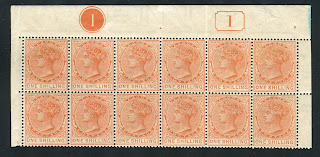I am going to veer off the topic of the last couple of posts and show you another aspect of Nigerian philately that is particularly satisfying over the longer term: the collecting of plate blocks. Plate blocks for the colonies of the British Empire is not a prominent field largely due to the fact that the blocks are very scarce and because the standard catalogues do not list them - so collectors do not know what exists. Because of this, it is possible to obtain some very scarce material for a fraction of what they should be worth based on their scarcity.
As an example, I illustrate a 1/- orange Queen Victoria, crown CA plate block that I acquired several months ago on e-bay:
This stamp was issued in 1885 and represents the highest of what at the time were low-value definitives. So in North American terms, this would be the equivalent of a 10 cent stamp from that period. I have not seen any data on what the issue quantity was, but I do know from a German publication that the print quantity of the bicoloured 1/- black and green that replaced it, and was in use from 1887 until 1903, was 26,220. Given that this stamp was in use for less than three years, is seems probable that the quantity was probably between 12,000 and 18,000. The stamps were printed in sheets of 60, so the number of sheets would probably have numbered between 200 and 300. There were two plate markings on each sheet - one at the bottom and one at thee top, so there would have been 2 blocks per sheet. Thus the total number of blocks printed was probably somewhere between 400 and 600 blocks. How many have survived? Its anyone's guess, but I would suggest that 5% of the original quantity would be high, and that would be just 20-30 blocks! How much do items that scarce sell for at auction when the country is US, Great Britain, or Australia for example.
I paid $296 for this block of 12. The stamps are all never hinged. The gum is a bit suntanned, which is normal for this issue, but the paper is still bright and fresh. Stanley Gibbons prices a hinged mint single at 14 pounds. While they do not price never hinged stamps, a reasonable premium for this time period would be about 200%, so each stamp in the block would have a notional catalogue price of 42 pounds. Thus the singles would notionally catalogue 42 x 12 = 504 pounds. So I paid 58% of that notional value, ignoring the exchange rate between dollars and pounds. Without any premium for being never hinged, Gibbons would value the singles at 168 pounds, so I paid roughly full Gibbons for hinged singles. This is a phenomenal bargain. Can you imagine being able to buy a 10 cent US Banknote plate block of 10 never hinged for the price of 10 hinged singles? I doubt it.
Most Nigerian issues were printed in relatively low quantities, and plate blocks were not generally saved, so that now they are all scarce, even for the very common stamps. So this area of collecting offers a considerable amount of potential for the patient collector.


